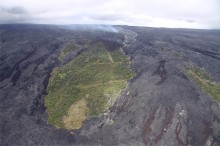You may have seen a brief mention in the news of a Hawaiian house being taken out by lava last week. Even though most of the mainland blurbs didn’t make it sound all that interesting, I have to admit that I think the background story is amazing.
Jack tells me he purchased his first lot there in 1972 on Queens Street in Royal Gardens; relocating to Plumeria Street residence in 1978. The subdivision contained 1500 lots on the Pulama Pali and coastal plains below. Jack likes telling the story about the day he was finishing the cedar house in early January 1983: Having just placed the windows into his upper loft bedroom, when that very night he saw an erie orange glow flashing on the panes– This glow was from huge lava fountains four miles upslope, he says this while waving his hands in the air like fountains, and was the very beginning of the eruption of Pu`u O`o January 3rd, 1983, which continues to this day.

According to other sources I’ve read, the first house in the subdivision was taken out by lava on March 20, 1983 – a little more than two months after the flow started. The Hawaiian Volcano Observatory gives a clue as to what residents faced in those early years:
…from 1983-1985, `a`a flows fed by lava fountains from Pu`u `O`o overran the upper slopes of the subdivision during 7 eruptive episodes. Residents lived on edge in those years, when every 3-4 weeks towering lava fountains lit up the sky and rattled the windows. Sixteen houses were overrun, and 20 percent of the subdivision was inundated. Streets running straight down the pali formed convenient pathways for the `a`a flows, which filled them to a depth of 5-10 m (16-33 ft).
One former resident says she evacuated about 30 times during the time she tried to live amid the flow. To make matters worse, in 1987, their road to Hilo was cut off. Apparently, several purchased second cars to keep on the outside of the flow. They would drive to the end of the roads in their trapped subdivision, hike a mile, and then continue their drive with the second car to run their errands. A trip to Hilo was now a 120-mile round trip. If the “inside” car was parked too close to the flows, it would get overtaken between their trips outside of the subdivision – something that apparently happened often. Apparently, they would bulldoze access roads for the next 13 years, but those never lasted long. They would be overrun, with the last one being completely taken out in 2000.
Here is footage from Jack Thompson’s friend, a photographer who was with him when they had to evacuate.

Great story. I can’t imagine losing my neighborhood over the course of 30 years.
This reminds me of some of the clinging on that Dune Road residents do on eastern Long Island. But in their case, the state and federal government subsidize the insanity and it’s not their indomitable will that allows them to weather the beach erosion.
It sounds like some tax funds have gone to helping the former residents to resettle, but I think they still had to buy the property or build the homes. I haven’t looked into it enough to really know what’s going on there, but I have read a few passing comments about it in other articles.
That type of assistance I can be a little more flexible on since when they bought their property, there had never been activity in that area. As Thompson said in one of his interviews, it was all rain forest when he initially moved there. According to what I saw from the USGS, what is now Pu‘u ‘Ō‘Š(the vent responsible for the flow) wasn’t even there at the time. Some form of resettlement help isn’t out the question, in my mind, when a volcano vent suddenly opens up near your home.
One of the really sad stories I read was the woman who talked about being evacuated from Royal Gardens about 30 times before they gave up, tore down the house, and rebuilt somewhere else. Unfortunately, they rebuilt in a neighborhood called Kalapana Gardens. Guess what subdivision was taken out in 1990? Talk about bad luck.